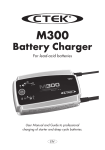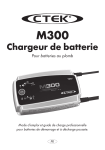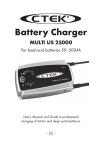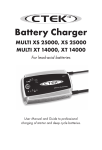Download User manual
Transcript
M300 Battery Charger For lead-acid batteries User Manual and Guide to professional charging of starter and deep cycle batteries. EN INTRODUCTION Congratulations on purchasing your new CTEK professional switch mode battery charger. This charger is part of a range of professional battery chargers from CTEK SWEDEN AB. It represents the latest technology in battery charging with charging and analysis in eight steps with temperature compensation. Read this User Manual and follow the instructions carefully before using your new charger. SAFETY • • • • • • • • • • • • • • • • • • The charger is designed for lead-acid batteries. Do not use the charger for any other purpose Use safety glasses and turn your head away when connecting or disconnecting a battery. Battery acid is corosive. Rinse immediately with water if acid comes into contact with skin or eyes. Seek medical advice. Make sure that the cable is not being pinched or in contact with warm surfaces or sharp edges. While charging, a battery can emit explosive gases, so it is important to avoid sparks in the immediate area. Always provide for proper ventilation during charging. Avoid covering the charger. Make sure that the electrical cable does not come into contact with water. Never charge a frozen battery. Never charge a damaged battery. Do not place the charger on the battery while charging. The electrical connection must fulfil the national heavy current requirements. Check the cabling in the charger before use. Make sure there are no cracks in the cabling or in the protective covering. A charger with damaged cables may not be used. Always check that the charger has gone over to maintenance charging mode before leaving the charger unattended and connected for long periods. If the charger had not gone over to maintenance charging within 3 days, this is an indication of a problem. In this case the charger must be disconnected manually. All batteries fail sooner or later. A battery that fails during charging is normally taken care of by the chargers advanced control, but certain uncommon errors in the battery can still arise. Don’t leave the battery charger unattended for a longer period of time. Only mount the charger on a flat surface. This equipment may not be used by children or by those who can not read and understand the manual if they are not supervised by a responsible person who can guarantee that the battery charger is being used in a safe manner. Store and use the battery charger out of the reach of children. Make sure that children do not play with the battery charger. When using outdoors the charger has to be positioned horizontally with the long side or top side turned up. CHARGING Connecting the charger to a battery fitted in a vehicle 1. The power cord should be disconnected when connecting or disconnecting the battery leads. 2. Identify the battery terminal that is grounded (connected to the chassis). The negative terminal is normally the grounded post. 3. Charging a negatively grounded battery. Connect the red cable to the positive terminal on the battery and the black cable to good metal engine ground away from the battery. Ensure you do not connect the black cable to fuel lines or sheet-metal body parts. 4. Charging a positively grounded battery. Connect the black cable to the negative terminal on the battery and the red cable to good metal engine ground away from the battery. Ensure you do not connect the black cable to fuel lines or sheet-metal body parts. Connecting the charger to an out of vehicle battery: 1. The power cord should be disconnected when connecting or disconnecting the battery leads. 2. Connect the red cable to the positive terminal on the battery and the black cable to the negative terminal. If the battery leads have been connected incorrectly, the reverse polarity protection system will ensure that neither the charger nor the battery are damaged. Start charging 1. Connect the charger´s AC cord to an AC Power Supply. The charger will indicate POWER, yellow indication lamp (B). 2. The lamp for completely discharged battery (1) will illuminate if the battery’s voltage is less than 12V. 3. Normal charging will be indicated by the following lights: completely discharged battery (1), bulk charging (2), absorption charging (3) or maintenance charging (4). When the maintenance charging lamp illuminates the battery is fully charged. Charging will start if the voltage drops. The charger can normally be connected for months. Reconditioning is indicated by the lamp (5) illuminating. 4. If the battery leads have been connected incorrectly, the reverse polarity protection system will ensure that neither the charger nor the battery are damaged. 5. If nothing happens. If the lamp indicating the setting and the power lamp remain lit but no other lamp illuminates, the connection to the battery or chassis may be poor or the battery may be faulty. Another cause may be a lack of voltage in the AC Power Supply. Begin by improving the connection between the battery and charger. 6. Charging can be stopped at any time by disconnecting the charger’s AC cord. Always disconnect the AC cord before disconnecting the battery leads. When you stop charging a battery installed in a vehicle you should always disconnect the battery lead from the chassis before disconnecting the other battery lead. 2 • EN BATTERY TYPES AND SETTINGS M300 can easily be set for different types of batteries or conditions. The following recommendations should, however, only be seen as guidelines. Please consult the battery manufacturer for further instructions. Settings are made by pressing the “MODE-button “ and stepping forward one press at a time until the required mode is reached, the button is then released. After about 2 seconds the charger activates the selected mode. The selected mode is saved in a memory in the charger and remains there even if the charger is disconnected from battery and mains. NORMAL NIGHT RECOND NORMAL - Normal setting for wet batteries, maintenance free and for most Gel batteries. Some Gel batteries prefer a slightly lower charging voltage. Please consult the battery manufacturer when in doubt. NIGHT – This mode is equal to NORMAL, but with reduced current. The built-in fan is disabled and the unit is almost silent. The Unit returns automatically to NORMAL after 8 hours. To ensure that the charger restarts in NIGHT mode in the event of a power failure the setting is stored in a memory. The indication shows “NIGHT” even if the charger has returned to NORMAL mode to remind that the charger will start in NIGHT mode next time. RECOND - This mode is used to recover deep discharged flooded batteries where you could expect a stratified acid (high acid weight in the bottom, low on top). Check with battery manufacturer when in doubt. Use this mode with care, because the high voltage will cause some water loss. 16V is normally no problem for electronics in 12V system. Consult your supplier when in doubt. Life of light bulbs will be reduced at higher voltage. Try to disconnect light from the battery during this phase. Maximum effect and minimum risk for electronics is achieved by charging a disconnected battery. CHARGING PHASES M300 charges and analyses in eight fully automatic steps. M300 has three different operating modes, see Battery Types and Settings. The battery charger has an 8-step fully automatic charging cycle: Desulphation Desulphation with pulses recovers sulphated batteries. Indicates with lamp 1. Soft start (Lamp 1) Start mode for the charging cycle. The start phase continues until the battery’s terminal voltage has risen above the set limit, at which point the charger switches to bulk charging. If the terminal voltage has not passed the voltage limit within the time limit, the charger switches to fault mode (lamp 0) and discontinues the charging. If so, the battery is faulty or its capacity is too large. Bulk (Lamp 2) Main charge when 80% of charging takes place. The charger delivers maximum current until the terminal voltage has risen to the set level. Bulk has a maximum time, at which point the charger automatically switches to Absorption. Absorption (Lamp 3) Complete charge up to virtually 100%. The terminal voltage is maintained at the set level. During this phase the current tapers successively. Once the current has tapered to the set limit, this phase switches to being timed. If the total time for Absorption exceeds the time limit the charger automatically switches to maintenance. Analysis (Lamp 3) Testing self-discharge. If self-discharge is too high, charging is discontinued and fault mode is indicated. Maintenance charging - Float (Lamp 4) Charging at constant voltage. Maintenance charging - Pulse (Lamp 4) Charging varies between 95% and 100% state of charge. The battery receives a pulse when the voltage drops and keeps the battery in perfect condition when it is not in use. The charger can be connected for months at a time. The charger continuously measures the terminal voltage to determine whether a charging pulse should be initiated. If the battery is loaded and/or the battery’s terminal voltage drops the charger starts a charging pulse until the terminal voltage reaches the set level. The charging pulse is then discontinued and the cycle is repeated infinitely. If the terminal voltage drops below a lower limit, the charger automatically goes back to the beginning of the charging curve. Recond (Lamp 5) This mode is used to recover deeply discharged flooded batteries. Recondition of deep discharged batteries. The voltage increases with reduced current for a limited time period. The higher voltage starts some gassing and mixing of the acid, which is beneficial for both battery capacity and expected life. Note that the battery could emit explosive gas during Recond. Recond is performed between Analysis and Maintenance. EN • 3 INDICATORS 3 2 0 A 4 5 1 B C D E Lamp 0 1 2 3 4 5 Description Fault mode, the charging is discontinued. For fault causes, see below. Start mode Bulk charging Absorption charging Maintenance charging Recond, reconditioning of completely discharged batteries. A B C D E Charging with temperature compensation. Mains voltage connected Normal Recond Night. Charging with reduced power and disabled fan for 8 hours. Fault mode The charger goes to fault mode in the following situations: • The battery is connected with poles reversed to the charger's terminals. • The charger’s analysis function has interrupted charging. • The terminals on the charger are short-circuited after charging has started. • The charger has been in start mode for more than 4 hours. TEMPERATURE COMPENSATION M300 has a sensor cable placed together with the battery cables. The units will automatically adjust the charging voltage if the temperature deviates from +25°C. A high temperature lowers the voltage and freezing conditions is handled by higher voltage. The temperature is best measured on or very close to the battery. Therefore always place the sensor as close to the battery as possible when charging. The sensor cable could be prolonged or cut to length with the same functionality. Activated temperature sensor will be indicated by a lit temperature sensor indicator lamp. The charging voltage is then adjusted to the +25°C condition. SPECIFICATION Model Voltage AC Charging voltage Charging current Current, mains Back Current Drain* Current ripple** Ambient temperature Cooling Charger type Battery types Battery capacity Protection class Weight 1013 170–260VAC, 50–60Hz. 14.4V 25A max. 2.9A rms (at full charging current) <2Ah per month <4% -20°C – +50°C Output power is automatically reduced at higher temperatures. Fan Eight-step, fully automatic All types of 12V lead-acid batteries (WET, MF, AGM and GEL). 50–500Ah IP44 (Outdoor use)*** 1.4kg *) Back current drain is the current that the charger drains from the battery if the AC cord is disconnected. **) The quality of the charging voltage and charging current are very important. High current ripple heats the battery and ages the positive electrode. High voltage ripple can damage other equipment connected to batteries. The battery chargers from CTEK produces very high quality voltage and current with low ripple. ***) IP44 cannot be guaranteed if the charger is not positioned horizontally with the long side or top side turned up. MAINTENANCE The charger is maintenance-free. The charger must not be opened; doing so will invalidate the warranty. If the power cable is damaged it must be replaced by CTEK or its authorized representative. The charger casing can be cleaned using a damp cloth and mild cleaning agent. Remove the plug from the power socket before cleaning. 4 • EN LIMITED WARRANTY CTEK SWEDEN AB, Rostugnsv. 3, SE-776 70 VIKMANSHYTTAN, SWEDEN issues this limited warranty to the original purchaser of this product. This limited warranty is not transferable and is only valid for non-commercial use. CTEK SWEDEN AB warrants this unit for 5 years from the date of purchase against defect workmanship or material. It is the obligation of the purchaser to forward the unit together with proof of purchase to the manufacturer or its representative with transportation cost prepaid. This warranty is void if the unit is abused, handled carelessly or repaired by anyone other than CTEK SWEDEN AB or its authorized representative. CTEK SWEDEN AB makes no warranty other than this limited warranty and expressly excludes any implied warranty including any warranty for consequential damages. This is the only expressed limited warranty and CTEK SWEDEN AB neither assumes nor authorizes anyone to assume or make any other obligation towards the product other than this limited warranty. DECLARATION OF CONFORMITY CTEK SWEDEN AB, Rostugnsvägen 3, SE-776 70 VIKMANSHYTTAN, Sweden, hereby declares under sole responsibility that the M300 battery charger, to which this declaration relates, conforms with the following standards: EN60335-1, EN60335-2-29 following the provisions of directive 73/23/EEC amended by 93/68/EEC and EN61000-3-3, EN61000-3-2, EN55014-1, EN55014-2 following the provisions of directive 89/336/EEC amended by 92/31/EEC and 93/68/EEC. CTEK PRODUCTS ARE PROTECTED BY Patents EP1618643 SE525604 US7541778B2 EP1744432 pending EP1483817 pending SE524203 US7005832B2 EP1716626 pending SE526631 US-2006-0009160-A1 pending EP1903658 pending EP1483818 US7629774 SE528232 EP09170640.8 pending US12/564360 pending EP09180286.8 pending US12/646405 pending Designs RCD 000509617 US D571179 US D575225 US D581356 US D580853 RCD 321216 RCD 200830199948X pending RCD 000911839 RCD 081418 US D29/319135 pending RCD 001119911 RCD 321197 RCD 321198 RCD 200830120183.6 pending ZL200830120184.0 RCD 000835541 US D596125 US D596126 2010-01-27 Trade marks CTM TMA669987 CTM 844303 CTM 372715 CTM 3151800 CTM 405811 CTM 1461716 pending SUPPORT CTEK offers a professional custom support: www.ctek.com. For latest revised user manual see www.ctek.com. By e-mail: [email protected], by telephone: +46(0) 225 351 80, by fax +46(0) 225 351 95. By mail: CTEK SWEDEN AB, Rostugnsvägen 3, SE-776 70 VIKMANSHYTTAN, SWEDEN. VIKMANSHYTTAN, SWEDEN 2010-06-01 Jarl Uggla, President CTEK SWEDEN AB EN • 5 PROGRAM DESCRIPTION Soft Start Bulk Absorption Recovers a sulphated battery Tests the battery condition Bulk charge Peak charge with minimal fluid loss Soft Start Bulk Absorption Current (A) Voltage (V) Desulphation M300 PARAMETERS Mode NORMAL or RECOND Desulphation YES Max 4h or until the voltage reaches 12.6V. 25A for max 20h. NIGHT Mode max 5A. 14.4V max 16h. Note: In NIGHT Mode the M300 operates in NORMAL Mode with reduced current and disabled fan. The unit automatically returns to NORMAL after 8h. 6 • EN Analysis Recond Float Pulse Tests whether the battery retains the energy Reconditioning of a drained battery Maintenance for maximum performance Maintenance for maximum battery life Analysis Recond Float Pulse Max 15.8V and 3A for 4h for deeply discharged batteries. Otherwise for 30 minutes (only in Recond mode). 13.6V with max 25A for max 10 days. Warning indication if voltage drops to 12.0V in 3 minutes. Pulse start at 12.7V, max voltage 14.4V. EN • 7





























